The final draft of the plan aims to reach carbon neutrality in the city of Davis by 2040
By MADELEINE YOUNG — city@theaggie.org
On April 18, the Davis City Council held its last meeting of the month to cover the allocation of funds for the Community Development Block Grant (CDBG) and Home Investment (HOME) funds for the fiscal year of 2023-2024 and adopt the final draft of the Climate Action and Adaptation Plan (CAAP).
Item 5 on the agenda covered the preliminary funding recommendations and annual action plan for the CDBG and HOME funds given to the city this fiscal year. These are federal funds that the Housing and Urban Development (HUD) allocates to assist low-income households and remove barriers in public facilities.
Kelly Stachowicz, the assistant city manager, brought before the council the preliminary funding recommendations during the required public hearing.
“This particular [20]23-[20]24 program year, we have not received our final allocations from HUD yet, but we are estimating that we will receive approximately $780,000 in CDBG funds and $460,000 in HOME funds,” Stachowicz said. “We have gone through all the processes necessary for the public outreach and input, we have received applications and gone to the social services commission to get their input as well”.
The council will spend a majority of the CDBG funds on public services, allocating extensive funds for programs such as Davis Community Meals, Empower Yolo and more to help with food insecurity and other needs, according to Stachowicz.
“The reason this is difficult is because this is limited to 15% of the overall funds available to us and the need is much, much greater,” Stachowicz said.
The bulk of the CDBG funds is spent on public facilities, specifically Americans with Disabilities Act (ADA) compliant projects such as annual Flatwork and improvements to Playfields Park. The remaining 20% is put towards fair housing and city administration.
The city will put $414,000 of the funds toward the Mercy Housing Project, which is creating senior housing in the Bretton Woods development. The remaining funds will be given to the city administration.
Moving onto Item 6, the council discussed the final 2020-2040 Climate Action and Adaptation Plan (CAAP). Diana Jensen, the director of public works engineering and transportation and CAAP project director, took the floor to present the final CAAP report, which has been slightly changed since the draft presented in December.
Jensen explained that the city council’s goal in updating the CAAP and integrating the plan into city policy is to reach their March 2019 resolution of attaining community carbon neutrality by 2040.
Kerry Loux, the city’s sustainability coordinator and the project manager for CAAP, presented the final report to the council. The CAAP was intended to implement the community vision adopted by the city council and serve as a planning document with recommendations for actions, based on an initial greenhouse gas inventory and vulnerability assessment.
“The actions in the plan are in five categories which are color-coded in the plan and the goal was to make them implementable and measurable,” Loux said. “We wanted to be able to say ‘This is what the action we want to do is and here’s how we are going to measure success and know what we are attaining with those goals.’”
The plan contains 28 action items that will help achieve carbon neutrality by 2040. It also addresses climate risk. The CAAP states that the implementation will prioritize community outreach and regional collaboration and work with city partners and proactive interdepartmental staff.
Josh Lathan, the architecture, engineering, construction, operations and management (AECOM) technical lead, then gave an update on the 2030 greenhouse gas reduction scenario, which estimated that the 2030 minimum target gap would be around 17,500 metric tons of carbon dioxide per year.
“The city has been working on the development of a ‘CAAP dashboard’ that will allow transparent tracking of CAAP implementation progress; the dashboard layout right now will show a high-level overview of greenhouse gas emission metrics,” Lathan said. “The dashboard would include some details about implementation for each of those 28 prioritized CAAP actions, things like projected milestone dates for those, a visualization that shows progress, some sample tracking metrics and an indication with icons of what the different co-benefits of those actions are.”
Written By: Madeleine Young — city@theaggie.org



